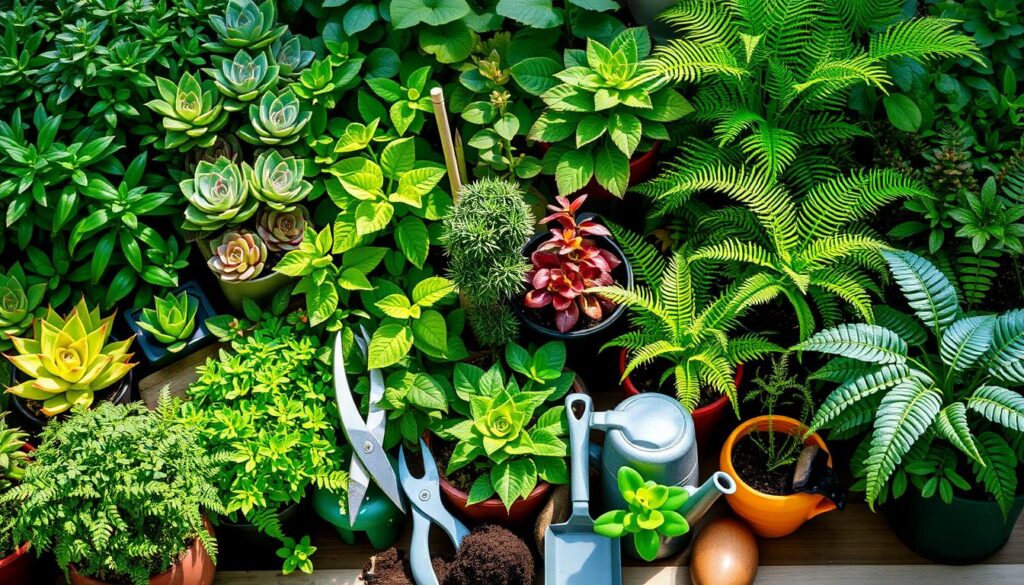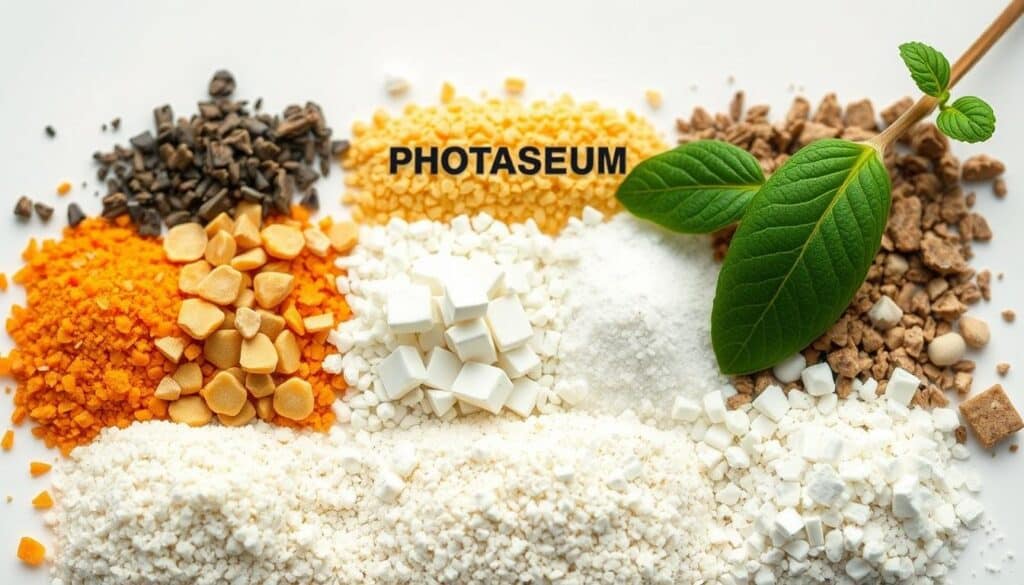Ultimate Guide to Plant Care Essentials

About the Game
Starting your plant care journey can make your home prettier. It’s good for exercise and cuts down on stress. Whether you’re new or a pro in taking care of houseplants, knowing the basics is crucial. This guide gives useful advice and tips for all skill levels, helping you grow a beautiful indoor garden.
Adding houseplants to your space helps clean the air, which improves indoor air quality by getting rid of pollutants. Taking care of plants can also make you feel better, reducing stress and bringing a sense of peace. This guide will teach you everything from choosing the right light to knowing when to water your plants.
This ultimate guide will go over important topics like what tools you need for taking care of plants, how to water them properly, choosing the right soil, and how to keep pests away. If you’re committed and have the right info, you’ll not only keep your plants healthy but also feel the joy of indoor gardening.
Anúncios
Understanding the Basics of Plant Care
Getting to know how to care for plants sets the stage for their success. Paying close attention to them regularly keeps them healthy. This helps them grow strong and makes your bond with them stronger.
The Importance of Routine Care
Routine care means plants get what they need to be their best. Setting a schedule for looking after them helps spot and meet their needs quickly. Important tasks include:
Anúncios
- Regularly checking soil moisture levels.
- Providing adequate watering based on the specific needs of each type of plant.
- Ensuring plants receive appropriate light exposure to facilitate healthy growth.
Basic Maintenance for Happy Plants
Good maintenance practices boost plant health and joy. Healthy maintenance means doing things that keep them in top shape, like:
- Removing dead or yellowing leaves to improve airflow.
- Inspecting plants regularly for signs of pests or disease.
- Maintaining cleanliness around the base of the plant to prevent mold growth.
Essential Tools for Every Plant Parent
Every plant lover knows the right tools make caring for plants more enjoyable. Starting with basic tools helps beginners not feel swamped. As you learn more, getting better tools can make your plants healthier. It’s all about knowing which tools are key and when to get better ones.
Must-Have Equipment for Starting Out
For newcomers to plant care, a starter kit should have:
- Watering can: Ensures adequate hydration without causing overwatering.
- Drainage trays: Protect surfaces and promote proper drainage for plants.
- Hand trowel: Ideal for transferring soil and planting new plants.
- Pruning shears: Useful for removing dead leaves and promoting growth.
Upgrading Your Plant Care Kit
As you get more confident and skilled, it’s good to add to your tool collection. This can make your plants even happier. Things to consider adding include:
- Hori hori knife: Perfect for digging and dividing perennials.
- Multipurpose spray bottle: Useful for watering, misting leaves, or applying fertilizers.
- Soil moisture meter: Helps ensure plants receive the correct amount of water.
Choosing the Right Soil for Your Plants
Picking the right soil is key to your plants thriving. The best potting soil improves plant health, growth, and balance. It ensures your indoor plants get what they need for strong roots and good health.
The Role of Soil in Plant Health
The soil’s quality affects how well a plant grows. Good soil keeps plants nourished and hydrated. It helps roots grow and plants take up nutrients. To help the soil, experts recommend not disturbing it too much. This helps keep it healthy for plants.
Types of Potting Mixes and Their Uses
Knowing about different soil types helps you pick the best for your plants. Let’s look at some types:
- Standard Potting Mix: Great for many plants, rich in organic stuff.
- Succulent Potting Mix: Perfect for succulents, with quick-draining materials like coco coir and perlite.
- Cactus Soil: Made for cacti, with things like sand and pumice that help water drain fast.
To get the best results, mix standard soil with things like sand for cacti and succulents. This mix drains well and suits their natural needs. By choosing well, you give your indoor plants a good environment to grow and stay healthy.
Watering Techniques for Optimal Growth
Watering plants right keeps them healthy. Knowing how to water affects their hydration and growth. Spotting too much or too little water helps give them what they need.
Signs of Overwatering and Underwatering
Finding the right watering balance is key to plant health. Too much water shows as:
- Yellowing leaves
- Root rot, leading to mushy roots
- Wilting, despite wet soil
Not enough water signs are different:
- Crispy leaf edges
- Soil pulling away from the pot
- Overall wilting appearance
Methods for Efficient Watering
Using good watering methods ensures plants get enough water. Two effective ways are:
- Deep watering: This gets water deep into the soil, helping roots grow down to find moisture.
- Bottom watering: Pots sit in water briefly. Plants drink through the bottom holes, getting enough water without overdoing it.
Lighting Requirements for Houseplants
It’s key to know how much light your houseplants need. Every plant has its own light needs that come from its original home. This could mean it likes less light or enjoys soaking up the sun. Figuring out these needs means your plants get just the right light. This leads to bright leaves and healthy plants.
Identifying Different Light Needs
Look for these signs to understand your plants’ light needs:
- Leaf color: Dark green leaves usually mean a plant likes less light. Light or variegated leaves do well in bright light.
- Growth direction: If a plant grows towards light, it probably needs more of it.
- Flowering: Plants that flower are often asking for more light.
These clues help give your plants the right amount of natural light. This encourages them to grow strong and beautiful.
Tips for Maximizing Natural Light
Try these ideas to give your plants more natural light:
- Move your plants with the seasons to catch more sunlight.
- Use mirrors or light-colored walls to bounce more light to them.
- Clean your windows regularly so more light can come through.
Following these tips will make sure your houseplants get enough light. This way, they’ll grow healthy and strong in your space.
Nutrient Management in Plant Care
Nutrient management is key to keeping plants healthy and full of life. Knowing the different kinds of fertilizers helps you choose the best way to nourish your plants. With the right fertilizers, you can fix any nutrient shortages and have a lush garden.
Understanding Fertilizers and Their Types
Fertilizers come in many forms to fit specific needs of plants. The main types are:
- Granular fertilizers: These slow-release options give nutrients over time. They’re great for long-lasting nourishment.
- Liquid fertilizers: Fast-acting, they’re perfect for quick nutrient boosts. They work well for all plants.
- Organic fertilizers: Made from natural sources, they improve soil and provide essential nutrients.
- Synthetic fertilizers: Created chemically, they offer exact nutrient mixtures for specific needs.
When and How to Fertilize Your Plants
The right timing and method are crucial for fertilizing plants. It’s best to fertilize when plants start growing actively. Consider these tips:
- Look at the plant’s growth and leaf color to gauge its nutrient levels.
- Pick a fertilizer that matches your plant’s exact needs.
- Always follow the directions to avoid giving too much fertilizer.
Good nutrient management means giving plants the right fertilizers at the right times. This practice keeps your plants healthy. They’ll grow better, making your indoor or outdoor spaces more beautiful.

Pest and Disease Prevention in Plant Care
Keeping plants healthy is more than watering and feeding them. Fighting pests is key to protect your plants from harm. Catching these pests early can prevent big problems in your garden. Knowing what to do helps you keep your plants safe.
Common Pests and How to Identify Them
Pests like aphids and spider mites love to attack plants. Knowing how to spot them is the first step to protection. Look for sticky leaves, webbing, or discolored leaves to find these pests:
- Sticky residue on leaves (a sign of aphids)
- Webbing between leaves and stems (indicates spider mites)
- Discolored or curling leaves (common with several pests)
- Visible insect presence on foliage
Checking your plants often helps prevent problems. Keeping leaves clean can lower the chances of pests and diseases.
Natural Remedies for Pest Control
If you find pests, natural remedies can help safely. Some options are:
- Neem oil – a natural insect repellent
- Insecticidal soap – effective against soft-bodied insects
- Homemade garlic or pepper sprays – beneficial for deterring pests
Using natural remedies is a greener way to handle pests. Starting early and picking safe options helps keep your garden healthy.
Repotting and Propagation Techniques
Knowing when to repot is key for plant health. Repotting makes sure plants have room to grow. Look out for roots coming through the holes or the plant being too tight in its pot. When you see these signs, get a bigger pot and new soil for growth.
Be gentle when repotting to keep the roots happy. Carefully take out the plant, check the roots, and cut off any bad ones. Then, put it in its new pot with soil and water it to help it settle in.
Repotting is just the start. Plant propagation is another great way to add to your garden. It’s a way to make new plants to share or keep. There are a few ways to do this:
- Cuttings: New plants can grow from stem or leaf cuttings after roots appear.
- Division: Splitting a plant into parts makes new ones and helps all of them grow better.
- Layering: When a branch is made to touch the soil and roots, it can become its own plant.
Learning to repot and propagate can really help your garden flourish. It leads to healthy plants and more variety in your collection.
Conclusion
As we wrap up this guide on taking care of plants, we see how key it is to know about plant health. By following top gardening advice and making it a part of your routine, your plants will grow better. Figuring out the best tools, soil, how to water, and keep pests away is vital for your plants’ success.
Besides just upkeep, growing plants connects us with nature and others who love plants, too. Learning more about gardening deepens our bond with various plants. Sharing what we know with other garden lovers improves how we look after our plants, making gardening even more satisfying.
By caring for your plants well, your place can turn into a lively, green haven. So, whether you’re just starting or have been gardening for a while, every plant you tend to makes your life greener and fuller. Dive into this adventure and let the beauty of nature fill your home.
FAQ
What are the essential factors for successful plant care?
How often should I water my houseplants?
What tools do I need to start caring for plants?
How can I identify my plant’s lighting needs?
What types of fertilizers are best for my plants?
How can I prevent pests from infesting my plants?
When should I repot my houseplants?
What is the best way to propagate my houseplants?
Game Details
No
No